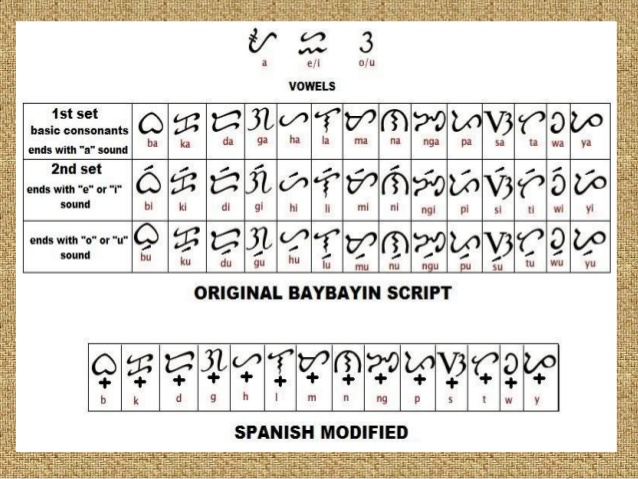Baybayin, not Alibata is the ancient Filipino writing system
Baybayin, not Alibata is the ancient Filipino writing system
➢ One major mistake of history includes the ancient Filipino writing system known to us as Baybayin. Majority of Pinoys mistake this traditional script as Alibata. This gigantic blot in Philippine history can be attributed to Paul Rodriguez Verzosa who mistook Baybayin to have come from the Arabic alphabet, and thus coined the term "Alif-Bata". Alif is the first letter in Arabic, and Aleph in Hebrew. It later became known as Alibata.
➢ One major mistake of history includes the ancient Filipino writing system known to us as Baybayin. Majority of Pinoys mistake this traditional script as Alibata. This gigantic blot in Philippine history can be attributed to Paul Rodriguez Verzosa who mistook Baybayin to have come from the Arabic alphabet, and thus coined the term "Alif-Bata". Alif is the first letter in Arabic, and Aleph in Hebrew. It later became known as Alibata.

Photo Credits: Baybayin from SlideShare.Net

Photo Credits: Baybayin from Wikimedia Commons
Baybayin is made-up of 17 characters or letters that became widespread in the Islands of the Philippines in the sixteenth century (confirmed by Pedro Chirino and Antonio de Morga). It flourished until it eventually faded under the Spaniard yolk during the 19th century. Those familiar with Baybayin describes it as curvilinear in appearance. Recent research points to the brahmic Sanskrit script from India as a probable ancestor of the Baybayin script. It may had been brought to Filipino shores by the Indian barter traders. Since 900 AD, researchers noted that there were traces of advanced writings in the Philippines (Laguna Copperplate Inscription).
Baybayin comes from the word "Baybay" in ancient Tagalog which meant "to spell" or "syllable" in Filipino. This form of classical script probably disappeared from national consciousness since Filipinos did not traditionally store-up writing scrolls like the Egyptians, Chinese and the Japanese did. The colonizing Spaniards also burned many Baybayin manuscripts to institute their own religious and cultural systems. However, Spanish clergy preserved it by documenting the script, with UST Manila holding the largest archive of Baybayin known presently.
Other scripts of Brahmic origins known in the Philippines include Buhid, Hanunó'o, Kulitan and Tagbanwa.
Note: Paul Verzosa was a member of the National Language Institute in 1939. He coined the erroneous term Alibata in year 1921.
References
• Morrow, Paul. "Baybayin, the Ancient Philippine script". MTS. Retrieved September 4, 2008
• Archives, University of Santo Tomas, retrieved June 17, 2012.
• "Tagalog (Baybayin, Alibata)". SIL International. Retrieved October 10, 2014.
• Archives, University of Santo Tomas, retrieved June 17, 2012.
• "Tagalog (Baybayin, Alibata)". SIL International. Retrieved October 10, 2014.
written by Rock Punzalan for Pinoy Search Network
FAIR USE DISCLAIMER: The following data is for educational, scholarship review and archiving purposes only. By viewing this information, you release the website and its authors from any responsibility or liabilities. Though we verify and maintain the accuracy of the provided data, the absence of unintented typographical and factual errors cannot be guaranteed. Use the page at your own risk. For any suggestions, updates, credits or correction requests, contact us or comment below.
Like Us
Trending Posts
- Korean War: When 900 Filipinos defeated a 40,000 strong Chinese Communist army
- 35 Must-Know Filipino Greetings and Phrases for Travelers
- Miguel Malvar – Forward without ever turning back
- Andres Bonifacio – I declare this assembly dissolved
- December 30, 1896 – execution of Jose Rizal
- August 21, 1983 – Assassination of Ninoy Aquino
- September 21, 1972 – Marcos declares Martial Law
- Philippine Adobo is not Adobar
- Binondo – world’s oldest Chinatown
- Kalaw – Clock of the Mountains
- Philippine Eagle – largest extant eagle in the world
- Top Filipino Heroes and their favorite food
- Top 50 Must-Try Fruits in the Philippines
- Ninoy Aquino – The Filipino is worth dying for
- Antonio Luna – I will fight and offer my life
- Antonio Luna – I am going not to command but to obey
- Macario Sakay – Death comes to us all sooner or later
- Jose Abad Santos – Do not cry Pepito
- Gregorio del Pilar – The general has given me the pick
- Ninoy Aquino – No to tyranny! No to corruption!
- Jose Rizal – What said those two souls communicating
- Jose Rizal – Cowardice rightly understood begins
- Jose Rizal – Our liberty will not be secured at the sword
- Andres Bonifacio – Reason teaches us that we must be united
- Andres Bonifacio – Reason teaches us that we cannot expect
- Andres Bonifacio – Love your Country next to God
- Ninoy Aquino – For seven years, I was not allowed
- Ninoy Aquino – The Filipino asked for nothing more
- Ninoy Aquino – It is a rare privilege for me to join the Motherland
- Ninoy Aquino – Son my decision is an act of conscience
- Jose Rizal – I have to believe much in God because
- Jose Rizal – He who does not know how to look back
- Jose Rizal – One only dies once, and if one does
- Abelardo Aguilar discovered Erythromycin
- March 17, 1521 – Magellan landed in Homonhon
- March 16, 1521 – Magellan discovered the Philippines
- Top 100 Bugtong Collection
- The Six Nations which invaded the Philippines
- Baybayin, not Alibata is the ancient Filipino writing system
- The many names of Lapu-Lapu













